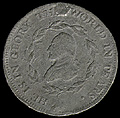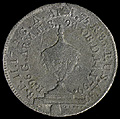Perkins Funeral Medal - 1800
obverse |
|
reverse |
| |||
Baker 166C Funeral Medal Die combination 1-B Jacob Perkins MA
Obverse: HE IS IN GLORY, THE WORLD IN TEARS.
Reverse: B. F. 11. 1732. G. A. ARM. '75. R. '83 P. U.S.A. '89 / R. '96 G. ARM. U.S. '98. OB. D. 14. 1799.
White metal Weight: 118.9 g (7.71 grams) Diameter: 29.2 mm Reverse die alignment: 360°
Comments: Washington died on December 14, 1799. Two funeral processions were held in Boston, the first was sponsored by the Masonic Lodge on Feb. 11, 1800 while the second was a general procession on February 22, 1800. According to Baker the Newburyport diemaker Jacob Perkins produced medals for each event. The two medals have similar obverses. The reverse of the medal for the Masonic procession, Baker 165, contains a legend in four lines with a small skull and crossbones at the bottom. The reverse of the medal shown above, though to be for the general procession, displays a legend in two lines with an urn in the center. Angel Pietri has discovered the Boston Masonic Lodge still owns an urn made by Paul Revere that contains a lock of Washington's hair. Pietri examined the procession in detail, using contemporary accounts. In the diary of the Reverend William Bently, who gave the funeral sermon for the Mason's event there is a mention of Perkins, "on this occasion so well known for his excellent medals ... of our General Washington." (Pietri, pp. 15 and 17). From this and the prominence of the urn in the procession Pietri suggests both Washington medals were produced and sold at the Masonic procession.
This example, in white metal, shows a bust of Washington facing left surrounded in a wreath on the obverse while the reverse displays a funeral urn and two semicircular lines of text. The medal was originally made with a small hole at the top, a small loop of wire would be put through the hole so the medal could be pinned onto clothing or suspended from a string. In this example the hole has been filled rather crudely.
According to Rulau and Fuld there are six die combinations of this type consisting of four obverses (1-4) and four reverses (B, C1,C2, D), each of which is known in both silver and white metal varieties. Approximately 25-40 examples survive of each type in silver and about 35-70 of each type in white metal. There are also two additional combinations (5-E and 6-F) thought to be patterns that survive in only two to three examples, all of which are in white metal. They differ in that the initials G.W. appear on the base of the urn. The example shown here combines obverse 1 and reverse B. Obverse 1 is found combined with both the skull and crossbone reverse designated as A1 as well as with the urn reverse called die B. Obverse 1 can be identified by the position of some of the double berries on the wreath, specifically the berries located underneath and just to the right of the W in WORD and under the center of the H in THE. The reverse of this medal shows the urn motif with a highly abbreviated legend standing for: "Born February 11, 1732. General of the American Army 1775, retired 1783. President of the United States of America 1789. Retired as General of the Army of the United States 1798. Obiit (Latin for died) December 14, 1799" This variety is identified as reverse B as it is the only variety with stops (that is, periods) after both U and S in U.S. (two other varieties have only a stop after the U and one variety has no stops).
Provenance: Part of an anonymous donation consisting of 1100 tokens and medals covering the Nineteenth century, primarily up through the Civil War era.
References: Rulau and Fuld, pp. 104-106; Angel Pietri, "The Washington Funeral Urn Medal and Paul Revere," The C4 Newsletter, Vol. 7, no. 1 (Spring 1999) 13-23.
| 1800 REPUBI. AMERI. Funeral Token |
Section Contents | 1805 Sansom Medal |

